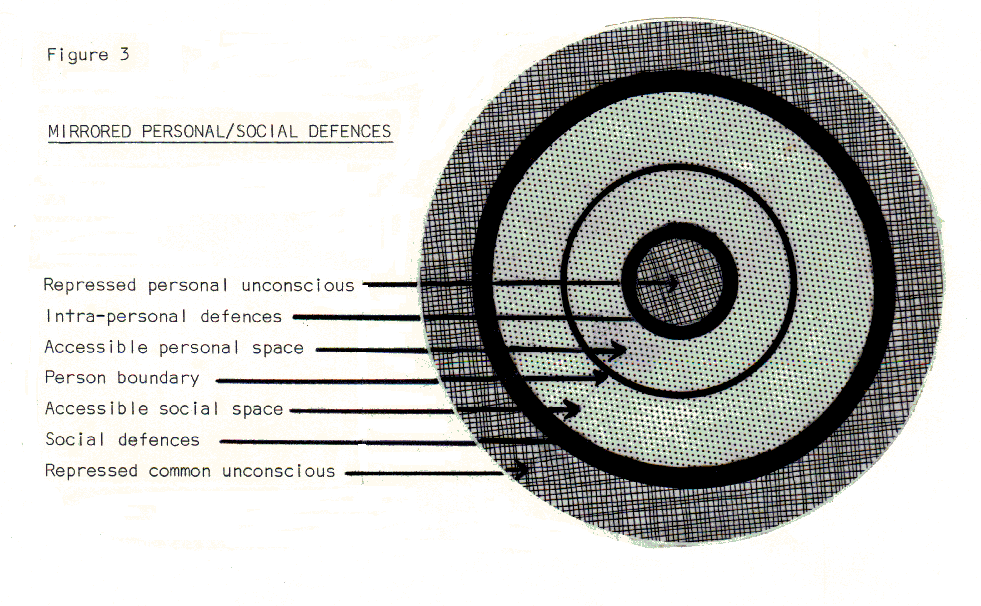 |
The Dynamics of Disarmament |
|
Introduces analysis of some of those unconscious
social processes which drive the arms race and motivate the various peace movements, so
many of which are hysterical symptoms of social anxiety rather than problem-solving
initiatives able to change the underlying causes themselves. It was published in the
September 1982 issue of ‘Chronicle’, the journal of the Dag Hammarskjold
Information Centre on the Study of Violence and Peace. [1982]
* * * * * * * * * * The development of international armour is a self-generating, exponentially increasing carcinoma of the world community. It poses a double threat to humanity in terms of direct destruction in the 'catharsis' of war and indirectly in the draining of an increasing proportion of world resources so attenuating the living standards of the rich and threatening the very survival of the poor. All attempts to exorcise the cancer have so far proved abortive, even counterproductive. The 'Hydra-factor' rules: try to disarm the enemy, removing the phallic snake-heads of his ICBMs and he grows multiple war heads! This article tries to probe behind the overt processes of the disarmament movement. Analysis of the causal dynamics at work in generating armour of the human system is essential if the progress of this potentially terminal disease is to be halted and the already grievous hurts are to be healed.
Unfortunately the in-group mobilises defensive armament to deal with the perceived threat however coloured by phantasy. The out-group, perceiving itself as a threatened in-group whose own out-group is clearly preparing for war, mobilises defensive armour, so accidentally confirming the paranoid phantasies of the first group. This process is exponentially self-generating. Signals given across the boundaries serve to reinforce those deep social anxieties which demand defensive armour for their suppression.
The more threatening the environment is seen to be the more all intra-national conflict, alienation and disruption are repressed so developing the characteristically unified internal state, highly defended boundary and denial of all humane/good elements in the environment. A society subject to such dynamics is much easier to rule. The requirements of the political process therefore elevate paranoid personalities to positions of leadership and foster paranoid behaviour at inter-national level in order to sustain power over the intra-national population. It is precisely these leaders who then engage in negotiations about disarmament while depending for their own personal psychological survival on precisely those paranoid dynamics they are overtly seeking to reduce. If, from the perspective of the UN a 'nation state' is a 'territory-holding society organised for war' then disarmament destroys the basis of nationhood. The UN itself was created out of the process of armed international conflict as an agency of international control whose overt task was to render such conflict less likely in the future. In effect the existence of the UN allows the exponential arms race to persist to higher levels without breakdown in war. The UN owes its raison d'être to the existence of armed nation states facing potential breakdown of boundary management. For the UN to succeed in disarmament negotiations would be to destroy its own foundations. So at international institutional level we face the same unconscious collusional dynamics enacted in the national political process. The UN acts as a council chamber for interaction between parties organised for war against each other. Disarmament implies a fundamental change, a paradigm shift in the nature of a nation state and as such would demand a paradigm shift in the international institutions themselves. If the world ever became one nation with all sub-boundaries dis-armed (as in the reduction of feudal substructures to foster national unity) then against what would the 'United Nation' be organised for war? Power vested in the UN would be seen as a threat to every member and the ultimate peace-keeping organisation would be perceived as the ultimate potential aggressor in defence against whose power the arms-race would redouble. Modern technology has changed the rules of the war game. No longer is international conflict a win-lose engagement in which the more powerful can afford to take the risk of armed conflict in order to defeat a less powerful neighbour. Today nuclear war represents a lose-lose engagement even for the most powerful. National armour is no longer a defence of the in-group. It is only a deterrent. The in-group is undefended, effectively held to ransom in an international game of hostages. The cost of escalating armour and heightened technology of destruction is the increase in levels of in-group anxiety sustained within the armoured ring. Today's national population perceives its defensive armour as threatening its own survival. This has lead to a fundamental shift in dynamics. No longer is all threat perceived as vested in the out-group with in-group government seen in the role of protector (with its ministry of 'defence'). Today's in-group perceives its own government as threatening, its own ministry of defence is seen as one with the enemy, posing a potential threat to the survival of the population. It is this major shift which lies behind the anti-governmental stance of the peace movement. From the perspective of government the peace movement is against the nation's interest and is therefore identified with the concerns of the out-group aggressor ... it is the enemy within. As a result there is a mirroring of the in-group/out-group reversal into the inner dynamics of every nation state. It is an illusion to see the peace movement as vectored toward disarmament. It is a supra-armour reaction to social anxiety, an hysteric response to terror similar in process to the dynamics which generated the armour in the first place. To disarm in fear is the antithetical achievement to disarmament in trust. Only the latter can under-gird a stable peace. If armour is symptomatic of anxiety then to request the removal of armour while leaving the causal anxiety undiminished is perceived as a violent, angst-generating threat to the system. Paradoxically, therefore, the disarmament movement actually generates social anxiety which in turn feeds the very paranoid processes which energise the arms race itself. Attempting to remove defence while sustaining the threats which it is designed to counter only intensifies the defensive behaviour. Humanity turns to the world religions in hope of finding some way through the impasse. A former secretary of the Social & Economic Council affirmed, "We need the Pope at the UN for we are not infallible in our judgements". Tragically religion codifies in myth, symbol and ritual those same deep defences of the common unconscious which are reified in the armour of social boundaries. If in somatic terms armour is the 'musculature of the many' (cf. Reich), then at a schizoid level religion is the armour of the mind. Confrontation across a boundary is never more violent, more resistant to rational resolution, more fuelled by projection of paranoid phantasy than when the boundary separates two mutually incompatible religious ideologies, be they Christian, Islamic or Jewish, Capitalist, Communist or Nationalist. Both religious systems and systems of defence, are projections of the same underlying dynamic. They seek to preserve the safety of the in-group from the terrors of the beyond by managing the boundaries of being. Religion calls on magic and the omnipotence of thought to deal with those threats and phantasies whose concrete control requires the madness of war. Religion may be 'safer' but it is no less symptomatic of social psychosis. Resurgence and renewal of the world religions are a response to rising stress in the global community. Like the growing peace movement, the escalating arms race, political instability and the insecurity of financial markets, mass religious awakening is symptomatic of social anxiety. Some angst is based in the realities of population increase, food shortage, attenuation of non-renewable resources, industrialisation, technological change and environmental pollution together with the socio-economic disparities whose roots lie in historic patterns of exploitation. However the capacity for rational problem-solving in the real field is increasingly overwhelmed by reaction to projected or phantasy anxieties which are overlaid on the realities. The processes used to handle this phantasy or psychotic level of anxiety are then used in reaction to any form of anxiety so blocking capacity for functional problem-solving at all levels of the human system. The defences called into action to protect the conscious mind from the psychotic levels of fear, rage, grief and desire deep in the unconscious world of the individual are also triggered by angst gener-ating experiences of adult reality. As a result those unknown areas beyond the boundaries of the social system tend to be populated with the terrors of the deep, held at bay by common collusional patterns of defence which mirror those similarly employed to man the ramparts of inner being (see figure 3).  Contrary to Freud's despairing fatalism of the 1930s (see the Editorial of the June Chronicle) the repressed core of human fear, rage, paranoia and aggression is not an instinctive and therefore unalterable part of the human psyche. It lies in those primitive traumatic experiences of engagement with the boundaries of being in the womb-world and the process of birth. Innate the defences may be, instinctive they are not. Common boundaries of the social system are irrationally defended in parallel to the common core of intrapersonal trauma. If the nation state is a society organised for war, it is because the individual is similarly organised in the depth of unconscious being. The social institutions erected to manage the boundary of the nation-state mirror the psychological mechanisms developed to manage the boundaries of inner consciousness. The phantasy threats projected across the social boundary, protection against which demands social armour, are in reality common reflections of those deeply repressed inner traumata buried in the defended core of the individual. It is impossible to solve the problem of the escalating armour of international boundaries while leaving undisturbed the causal dynamics of common intra-personal defences which generate the problem. Minor manipulation of symptomatic phenomena, while preserving causal system dynamics, is NOT a long-term solution to the problem. It is essential to understand the origin, functioning and effects of intra-personal defences against anxiety and their projection into every level of the social system. Only in so far as paranoid phantasy is withdrawn are we able to mobilise co-operative problem-solving in the real world of transactions across the boundaries of social systems. Such a movement is of all to be most resisted for it faces every-man with those deep levels of psychotic terror, rage, grief and desire laid down in primal trauma. From this material, and at every level of social being, humanity is in flight. |